Article Summary
DeepSeek has become a global AI phenomenon through its high-level and low-cost strategy.
• 🚀 The number of users has increased dramatically in a short period of time, and its global influence is approaching that of ChatGPT
• 💡 The technological innovation path reduces costs, and the open source strategy promotes popularization
The launch of DeepSeek-R1 has prompted global capital to re-evaluate the value of Chinese technology companies. On February 11, it was reported that Liang Wenfeng’s wealth has surged due to the success of DeepSeek, and his net worth may surpass Nvidia CEO Huang Renxun, becoming the richest man in Asia’s new technology industry. According to a Bloomberg survey, DeepSeek’s valuation is between $1 billion and $150 billion, and Liang Wenfeng holds 84% of the shares. Investment banks are optimistic about DeepSeek and believe that its valuation can reach half of OpenAI, that is, $150 billion. The value of Liang Wenfeng’s shares may reach $126 billion, exceeding Nvidia CEO Huang Renxun’s $118 billion.
From the end of December last year to the end of January this year, in one month, the number of DeepSeek users worldwide surged from 347,000 to 119 million. Dr. Liu Zhen, founder of Xsignal , believes that “the DeepSeek phenomenon is fundamentally different from the popularity of AI applications such as Doubao last year.”
According to the latest DAU (daily active users) data provided by Xsignal,As of February 8, the average daily active users of DeepSeek’s domestic APP reached 34.94 million; the DAU of the overseas APP reached 36.85 million, and the daily active users of the global Web reached 48 million. The total number of daily active users worldwide reached 119 million.
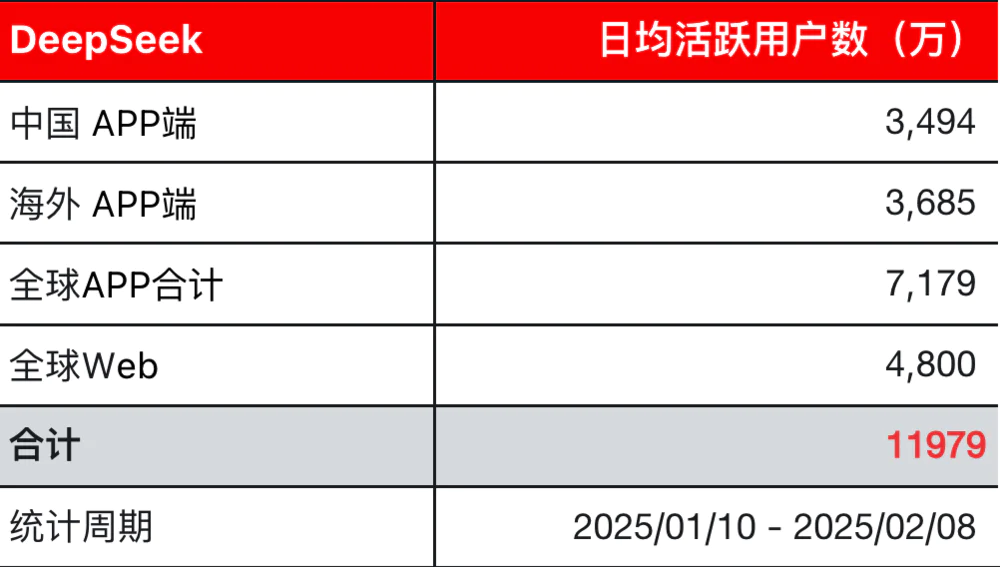
What does this set of data mean?
From the perspective of the global AI application track, it took ChatGPT two years to reach this user scale, while DeepSeek achieved it in just over a year.
In China, DeepSeek directly refreshed the user volume rankings of major domestic models such as Doubao, Kimi and Wenxin Yiyan. In January 2025, DeepSeek’s average monthly active users jumped to first place.
DeepSeek seems to have become popular overnight. However, judging from the periodic data of its own growth dynamics, this “huge fortune” did not come “suddenly”. Taking time as the axis, by comparing DeepSeek’s internal model iteration process and external user growth data, we may be able to better understand the key time nodes of DeepSeek’s “transformation”.
Four key moments in DeepSeek’s rise
Since 2024, DeepSeek has been continuously iterating and upgrading at an astonishing speed. Its development process is as follows:

- January 5, 2024: DeepSeek LLM debuts, DeepSeek’s initial exploration in the field of large language models.
- February 5, 2024: DeepSeek-Math version is launched, focusing on the ability to solve mathematical problems.
- March 11, 2024: DeepSeek-VL was released, introducing visual language fusion technology and expanding the application scenarios of the model.
- May 7, 2024: DeepSeek-V2 was released, which optimized the fluency and accuracy of language generation.
- June 17, 2024: DeepSeek-Coder-DeepSeek-VL2 was launched, further enhancing code generation and multimodal interaction capabilities.
- October 17, 2024: DeepSeek-Janus version is launched, introducing multi-language and cross-domain capabilities.
- December 13, 2024: DeepSeek-VL2 upgrade, improving the performance of visual understanding and generation.
- December 26, 2024: DeepSeek-V3 was released, further improving the overall performance of the model.
- January 20, 2025: DeepSeek-R1 is released. With its powerful performance and innovative features, it quickly tops the US App Store free list.
- January 27, 2025: DeepSeek-Janus-Pro version is launched, providing more powerful functional support for professional users.
Combining the following DeepSeek user growth data, Liu Zhen analyzed: “Its ‘explosion’ is not without warning. There are several key time nodes: April, October, December 2024, and January 20, 2025.”

Since April last year, DeepSeek has experienced a wave of rapid growth, with the DAU data on the Web side continuing to rise. The following set of monthly changes in DeepSeek’s all-media voice are consistent with the trend of active users.

Looking at the bigger picture, on January 20, with the release of DeepSeek-R1, the daily voice trend of all media showed a qualitative change. It began to grow rapidly from January 26 and continued until February 10, with the daily media voice exceeding 200,000.

Based on the above data, we can roughly make the following conclusions : The release of DeepSeek-R1 on January 20th completely ignited DeepSeek. So, what is the magic of the R1 model? What is the logic behind the explosion of DeepSeek?
There are several key words for the success of DeepSeek: China, high level, low cost, new path, and open source.
First of all, DeepSeek is technically strong. In the artificial analysis quality index data given by Artificial Analysis, the R1 model has reached a level comparable to the ChatGPT-o1 reasoning model. We can also see this from the fact that OpenAl had to respond on February 8 and released o3-mini.
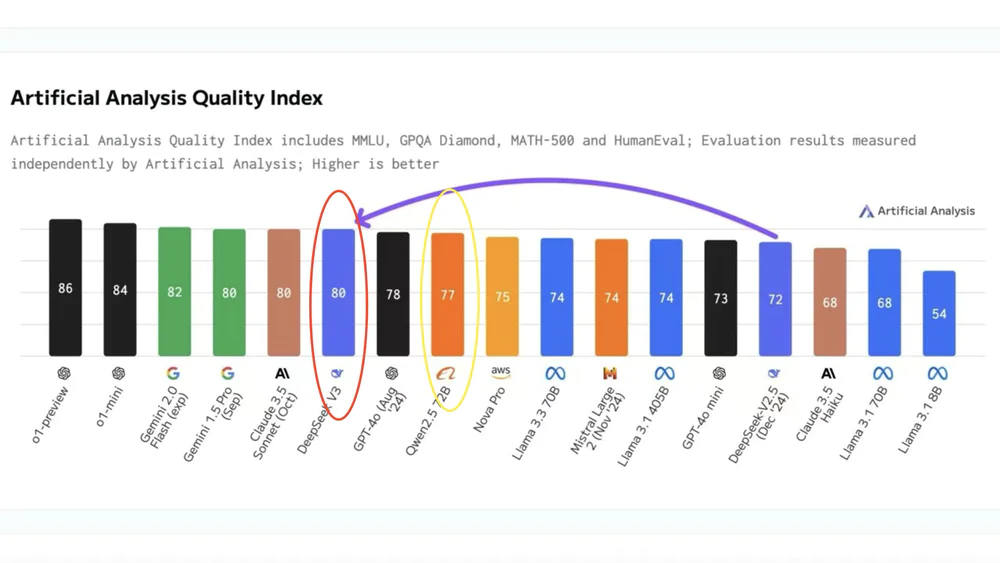
Secondly, from the perspective of research and development, DeepSeek has adopted a clever technical path, which has greatly reduced the cost of training and reasoning by optimizing the model architecture and training methods. For example, its MoE (Mixture of Experts) architecture achieves efficient computing resource allocation through dynamic routing technology, and the reasoning cost is only 17% of GPT-4 Turbo. This low-cost new development path is a good inspiration for improving the capabilities of domestic large models. However, as we will talk about later, this follow-up development method also buries “concealed concerns” for the upper limit of the capabilities of large models.
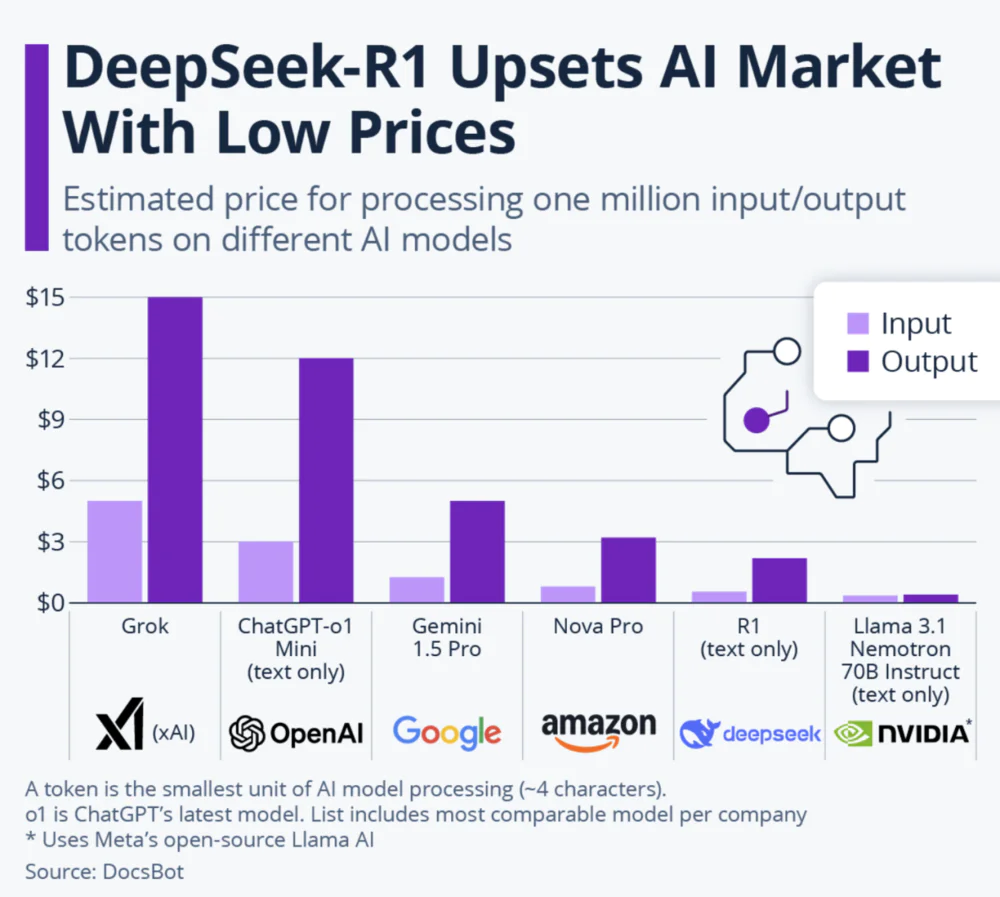
This does not mean that the entry threshold for AI big models has been lowered. DeepSeek is not completely “low-cost”. When the model was first created, DeepSeek training model also consumed a considerable amount of GPU. Magic Square Quant paid a considerable investment for this in the early stage. In other words, a model must be trained first.
In addition, in the context of the AI competition between China and the United States, the United States has always been “in the lead” in the field of AI in public opinion. China’s development of its own large models is subject to multiple restrictions on hardware and technology such as overseas chips and computing power. Starting from the Biden administration, the United States has adopted measures such as restricting high-performance chips. In addition, most of the top large models abroad are not open source.
Deepseek has taken an innovative path in a resource-constrained development environment. It has matched the international leading level in technology and has also innovated in application scenarios and user experience. Its sudden emergence has shocked both China and the United States. In China, Deepseek has inspired national pride. In the United States, Deepseek has shocked Silicon Valley with the AI strength of the Eastern superpower. As a result, Deepseek has become a common hot topic in both countries.
At the same time, DeepSeek’s open source strategy is also one of the important factors for its success.
We know that ChatGPT-o1 is charged, but DeepSeek’s open source of the same high-level model has greatly attracted ordinary users, which is conducive to the popularization of large-model end-side applications and the development of the ecosystem. At the same time, its closed-source version provides customized services for corporate customers to meet the needs of different users. This dual-track strategy not only promotes the diversification of the industry ecosystem, but also breaks the monopoly of closed-source models, forcing large models including OpenAl and Google Deepmind’s full series to launch low-cost version models, which greatly promotes the popularization, inclusiveness and equal rights of AI.
DeepSeek and Doubao: Two different paths to local rise
In fact, this is not the first time that a local AI model has become popular. In 2024, DeepSeek had not yet emerged, and domestic large-model-driven AI applications such as Doubao and Kimi had also gone viral on multiple online platforms. However, Liu Zhen said that the internal logic behind DeepSeek’s popularity was obviously different from that of AI products such as Doubao.
Taking Doubao as an example, the popularity of DeepSeek and Doubao is first of all the difference between corporate promotion and national promotion.
Let’s take a closer look at a set of full-media volume comparison data from DeepSeek and Doubao.
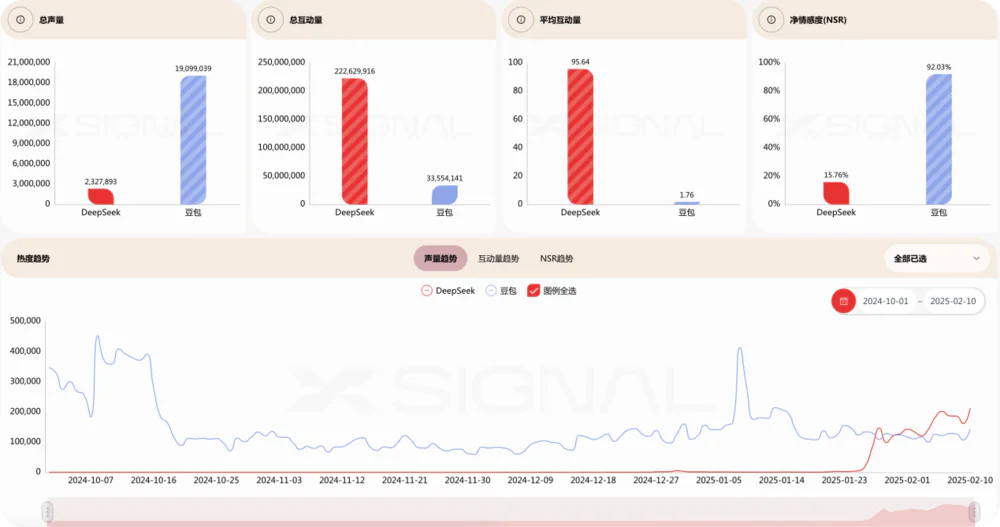
The first part shows the total voice of all media, Doubao is 8 times that of DeepSeek; but in the total interaction volume in the second part, DeepSeek is 7 times that of Doubao, far exceeding Doubao, and the same is true for the average interaction volume.
It can be seen that DeepSeek has received a lot of media interaction and has been the hottest topic in the past four months.
Combined with the following distribution data of all-media news, social media, and short videos, it can be clearly seen that 90% of Doubao’s traffic comes from short videos, and its popularity is due to the blessing of ByteDance’s naturally good ecology; and in DeepSeek’s media voice, news, social media, and short videos are evenly distributed.
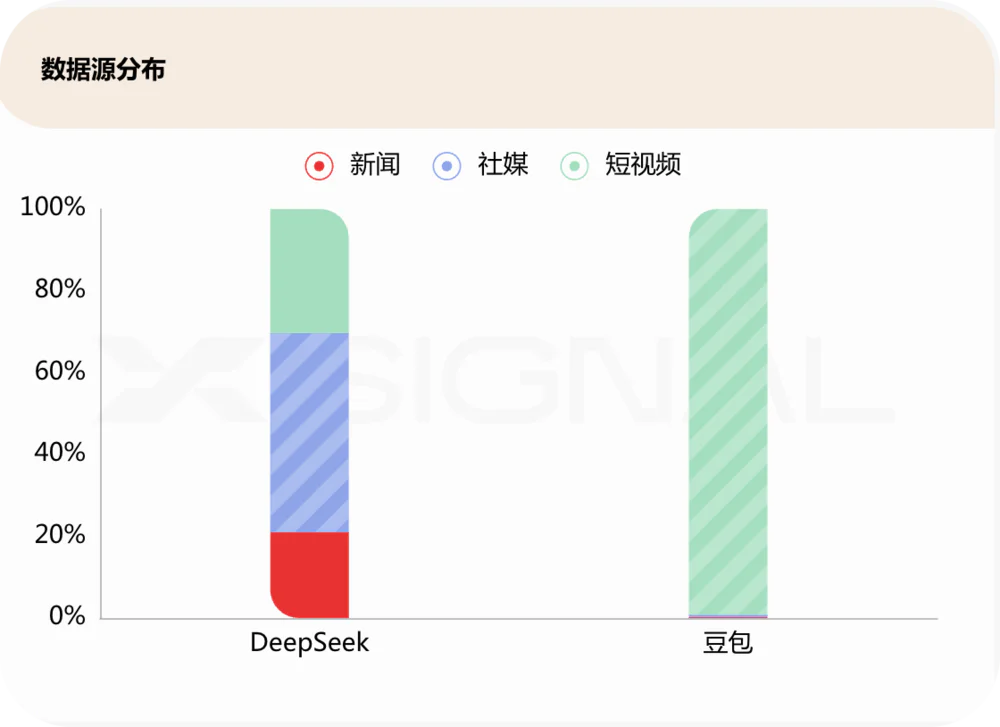
In other words, judging from all media data, news and social media have played a huge role in promoting the spread of DeepSeek, while Doubao is more spread in its own traffic ecosystem (short videos).
In addition, looking back at DeepSeek’s DAU data, the domestic APP of DeepSeek reached 34.94 million, while the overseas APP reached 36.85 million, and the global Web reached 48 million. The overseas market contributed almost half of DeepSeek’s user volume. As for Doubao, we know that it is mainly aimed at domestic users. This also shows the difference in market positioning between DeepSeek and Doubao .
There are multiple explicit and implicit reasons for DeepSeek’s popularity. The combination of high level, low cost, open source and free factors has created a natural traffic explosion point. The national competition under the global AI competition situation has pushed it to the “trend of the times”.
After DeepSeek’s “shocking” debut, many netizens are curious about what changes have taken place in the ranking data of large models in China? Can DeepSeek’s success be “replicated”?
Before DeepSeek became popular, the DAU ranking of domestic large models was relatively stable. The top three were Doubao, Kimi and Wenxinyiyan. The following are the MAU (monthly active users) data of the APP and Web in 2024.
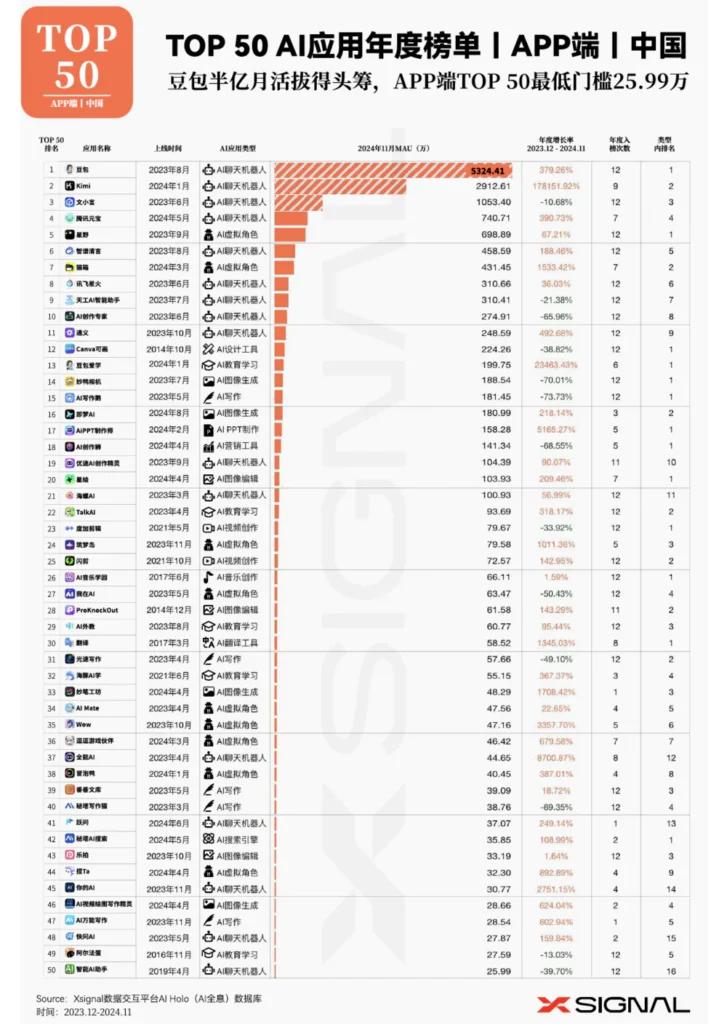
DeepSeek did not release the APP until January 20, so there is no APP data, only the following Web data.
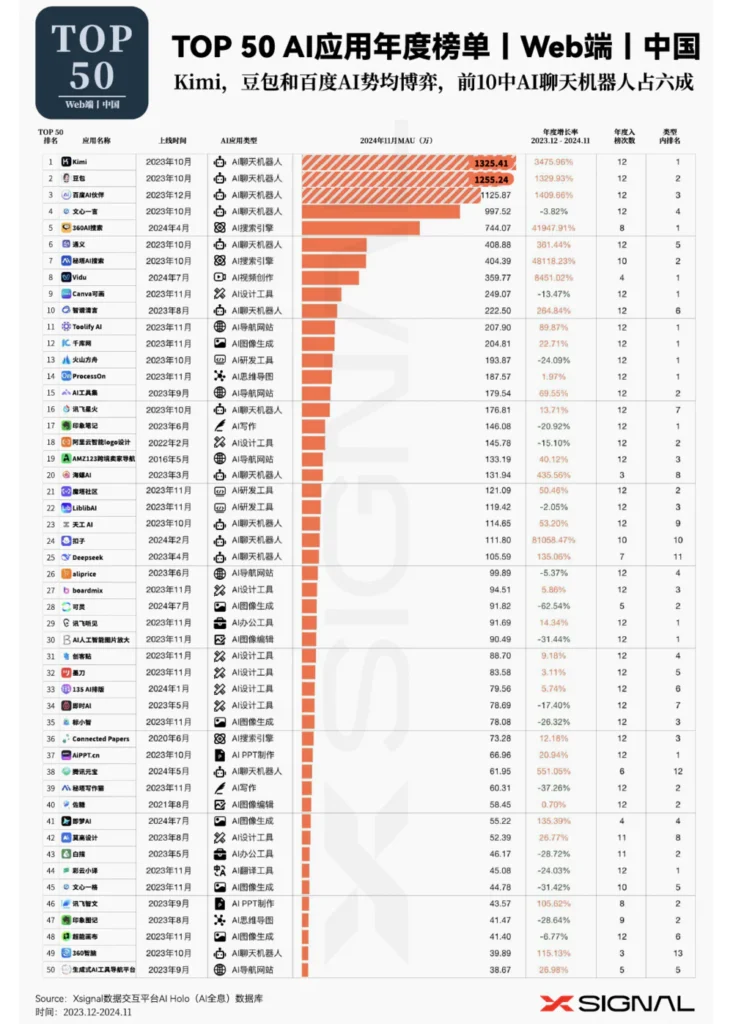
But even on the Web, DeepSeek was still largely ignored at that time and was far from being on the TOP50 list.
Xsignal pointed out to Huxiu that the V3 version was launched on December 26, and the R1 version was launched on January 20. Before January 20, DeepSeek R1 and APP had not been released, and its DAU data on the web side in December was only 347,000.
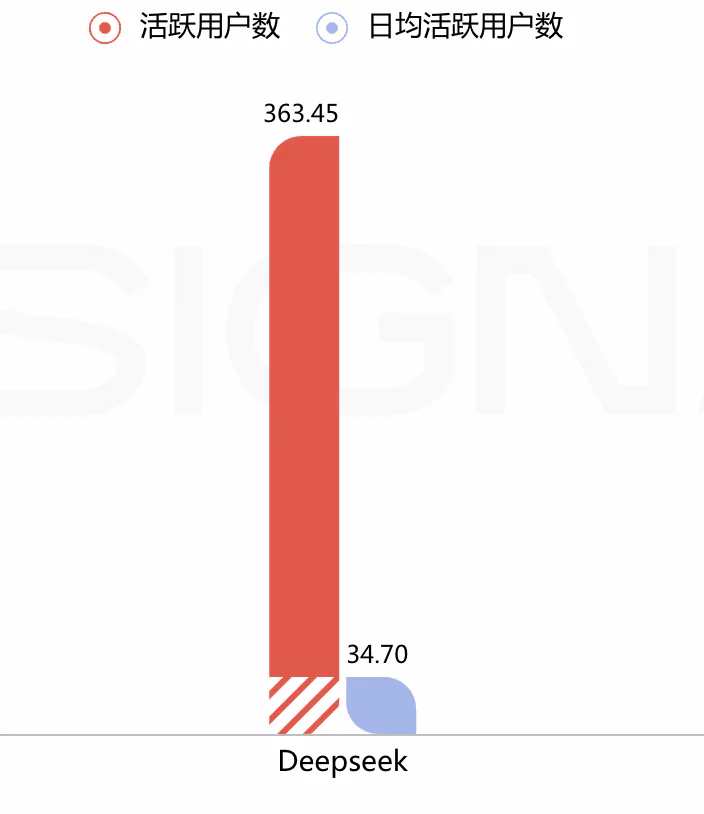
The following story is familiar to everyone. The emergence of DeepSeek broke the original balance. Within half a month, the ranking of domestic large models changed significantly:

From January 10 to February 8, according to the average DAU monitored by Xsignal, DeepSeek almost caught up with ChatGPT with nearly 120 million daily active users, and surpassed Doubao, Kimi and Wenxiaoyan in one fell swoop. Doubao, which ranked second, had a DAU of about 25 million, which is also a considerable difference.
This is a process in which the number of users increased from 350,000 to 100 million, which can be called a “miracle.”
DeepSeek’s “miracle” has also aroused some doubts and concerns from the outside world.
What new inspirations does DeepSeek bring to the industry?
On the one hand, pay attention to its capabilities.
Liu Zhen analyzed to Huxiu that DeepSeek has performed well in the open source field, and its technical capabilities and application scenarios are at the leading level in the industry. “However, its technical model also has some limitations. How to go from “intelligent following” to “intelligent leading” is the problem that DeepSeek needs to overcome next.”
In addition, DeepSeek uses lower costs to train high-level models and has some unique features of its own.
- Accuracy: In order to reduce training time and cost, DeepSeek sacrifices accuracy and inference time to a certain extent. In the future, we need to find a better balance between accuracy and inference efficiency.
- Stability: As the user scale expands, DeepSeek’s stability faces challenges. Errors and downtime have also occurred on social media platforms. In the future, the model architecture needs to be further optimized to improve the stability of the system.
- Maintenance costs and computing power costs : The maintenance costs and computing power costs of large models are high. DeepSeek needs to reduce costs through technological innovation and resource optimization, and find its own business model.
- Security and ethical risks: Looking back at the previous data, we learned that DeepSeek’s overseas user base is nearly twice that of its domestic users. In an international context, facing cultural differences and a world with diverse moral ethics, how to avoid TikTok’s past experience and find a development model that suits itself, while achieving an internal input/output closed loop and truly contributing to the universal and equal rights of AI, is also an issue that DeepSeek urgently needs to address.
On the other hand, the outside world is not only concerned about DeepSeek, but also about the future commercialization path of the entire AI industry’s big model.
Data from all media shows that DeepSeek’s interaction volume and popularity have been gradually declining. After all, the media’s attention is limited. After returning to normal, how should DeepSeek find its own business model?

The emergence of DeepSeek has greatly promoted the popularization of AI, enabling C-end users to use high-quality AI services for free, breaking the stereotype that “open source model = low quality and low level” and breaking the monopoly of closed-source models. This concept of technological equality has not only promoted the widespread application of AI technology, but also brought new opportunities and challenges to the global AI market.
Liu Zhen told Huxiu that 2024 is the first year of AI application. 2025 will be the first year of AI Agent, and intelligent task completion will become an important trend. The emergence of large reasoning models, the development of emotion recognition technology, and the maturity of autonomous evolution systems provide opportunities for the application of AI Agent. In this process, AI Agent will gradually be able to independently complete a series of tasks, rather than a single task.
Data shows that the global AI Agent market is expected to exceed US$50 billion, with a compound annual growth rate of 147%. At present, our understanding of intelligent agents is still relatively narrow, and in the future we need to further expand their application scenarios and functions, such as medical diagnosis (accuracy increased to 92%) and financial investment research (decision-making efficiency increased by 3 times).
For the global AI market, the rise of DeepSeek has first promoted competition in the global AI market, prompting Google and OpenAI to launch new models and lower the fees for AI models. DeepSeek’s open source model not only provides developers with more choices, but also promotes the widespread application and innovation of AI technology, broadens the boundaries of the market, and correspondingly brings confidence to investors.
However, some things have not changed, such as the development of the chip industry. The popularity of DeepSeek has brought AI into the eyes of more people. As more and more people use AI, the demand for AI continues to rise, and the situation of chip companies such as Nvidia is improving. This also declares the urgency of China’s development of hardware such as chips. The capabilities of chips need to be developed urgently in order to gradually become independent and even reach the world’s leading level.
For the Chinese AI community, DeepSeek provides new technical ideas for China’s AI big models, which is conducive to domestic enterprises to accelerate technology research and development and product iteration. At the same time, with the popularity of DeepSeek, the entire AI market has become hot. In this process, Xsignal, based on data analysis, believes that the Chinese AI community needs to look at the DeepSeek phenomenon objectively and calmly, and continuously review its own development strategy. On this basis, there are several growth points worth paying attention to.
First, pay attention to the ecosystem. As a commodity, AI applications need an ecosystem to promote their development. For example, the popularity of Doubao relies on the traffic ecosystem of ByteDance. In addition, the hardware ecosystem is also very important. Companies with hardware terminal ecosystems, such as Apple and Huawei, will have more advantages in the development of AI applications.
Second, pay attention to vertical tracks. Taking virtual social networking as an example, after AI technology developed to emotion recognition, the MAU of the AI virtual character Xingye APP has reached nearly 7 million, and the number of annual rankings has reached 12 times. The survey data on both user stickiness and willingness to pay are quite good, which shows that there is still a large market for emotional companionship AI applications in China, and it is also valuable to deepen the vertical track.

Third, pay attention to the development of AI applications . In the Internet era, China’s APP application level is leading the world. Perhaps we can also learn from the experience of the Internet era, promote the scenario application of AI technology, and let AI truly enter human life.
This in turn can also answer the previous question: Can DeepSeek’s success be “replicated”? In other words, is it possible for DeepSeek-level success to happen again?
“My answer is: maybe,” Liu Zhen told Huxiu, “China’s development in APP applications has achieved results that have shocked the world. In the era of artificial intelligence, China will also have leading innovation and popularization in AI applications. In the context of long-term AI competition between China and the United States, there may be more and more ‘DeepSeek’ phenomena. Just like in the Internet era, where there are people, there is demand, and where there is demand, there is a market. China has a large population base, and where there is a market, there will be innovation. I am very confident about this.”
Author:彭昭
Source:“物联网智库”(ID:iot101)
The copyright belongs to the author. For commercial reprints, please contact the author for authorization. For non-commercial reprints, please indicate the source.






